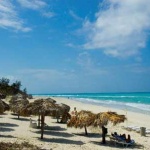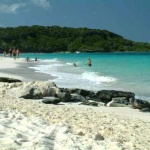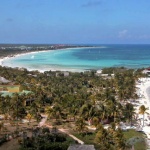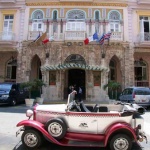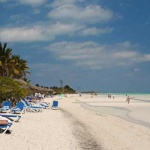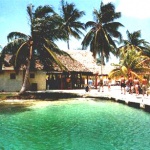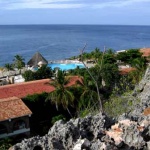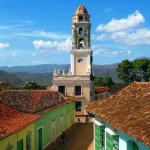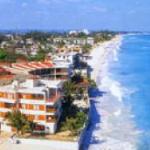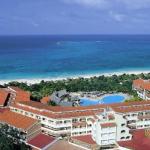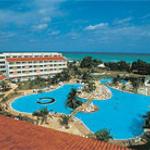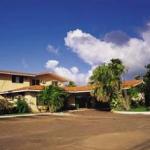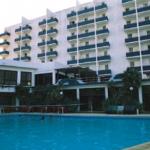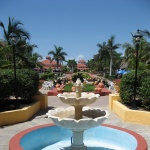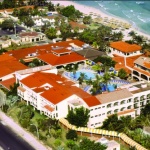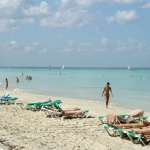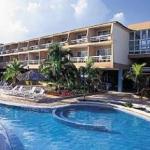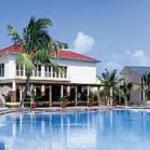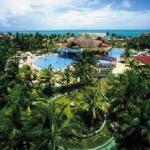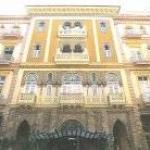Cuba Sights
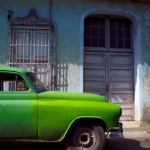 Despite numerous political upheavals, which is so rich in history of this country, Cuba remains one of the most visited tourist destinations in the Caribbean Sea. Hundreds of thousands of tourists from all over the world come annually to Cuba, attracted by its warm climate, beautiful sea, the rich history of the island and the famous Cuban cigars and rum.
Despite numerous political upheavals, which is so rich in history of this country, Cuba remains one of the most visited tourist destinations in the Caribbean Sea. Hundreds of thousands of tourists from all over the world come annually to Cuba, attracted by its warm climate, beautiful sea, the rich history of the island and the famous Cuban cigars and rum.Havana is located on the north-west of the island, and traces its history back to 1515 is very picturesque town - the magnificent mansions of the period of Spanish rule side by side with buildings in the style of "developing socialism", ultramodern skyscrapers - with shabby houses margins, and grandiose hotels in the coastal area of the city -- numerous churches.
The historic core of the city - Old Havana, is located around the port and Havana Bay. Narrow strait in the harbor with the two parties to protect the ancient fortress of Castillo del Morro (1589-1630 gg.), Castillo de la Punta (Castillo de San Salvador de la Punta), and the lighthouse (1845 .), and the western shore - Fort La Cabaña (San Carlos de la Cabaña) and La Real Fuerza (1555-77 gg., the oldest fortifications in America), which now houses the Museum of ancient weapons . From Havana's seafront Malecon (a favorite walking place of citizens and the arena of the traditional Carnival in February), stretching almost under the walls of the forts, begins the main street of Havana - Paseo del Prado, or simply Prado. Boulevard is one of the major monuments of old Havana - paved with marble slabs and planted trees, built mansions in staroispanskom colorful style, today it is one of the favorite vacation spots. Prado is located on the National Capitol building, built in the image and likeness of Washington, is here placed Cuban Academy of Sciences, the National Library of science and technology museum. Nearby are the former Presidential Palace (now - Museum of the Revolution), Governor's Palace (now the Museum - City of Havana) and the memorial "Granma", in honor of the legendary yacht, where the Cuban revolutionaries led by Castro landed on the island in 1956
To the west of the bay are small chapel of El templet (1828) at the birthplace of the city, as well as beautiful architectural complexes of the Plaza de Armas (Weapons Square) with magnificent buildings Palacio de Los Kapitanes-Henerales, Plaza de la Catedral (Cathedral Square) to the Cathedral of St. Christopher (1748-77 gg.), Plaza Vieja (Old Square) and via the Trocadero with the building of the Palace of Fine Arts - one of the best art museums in the Western Hemisphere.
In Havana, many museums, among which the most distinguished museum to combat illiteracy, the National Museum, the Colonial and Anthropological museums and museum-house in the estate of Ernest Hemingway's "Vigía, Historical Museum Guanabokoa and a sort of" museum wall "bar" Bodeguita del Medio , which stores the set of autographs of famous people of the twentieth century. Be sure to visit the Monastery of Santa Clara (1644), the Cathedral of the Immaculate Conception (1656), Town Hall (1792), the largest in Havana park named after Lenin, the Botanical Gardens with a unique Japanese garden, as well as the largest in America Zoo. Also of interest is one of the most magnificent monuments of the capital - 18-meter high statue "Christ of Havana, near the fortress of La Cabaña, Cabaret Tropicana", a museum of African art in the open air - per Ammel near Cayo Huezo, Garcia Lorca Theater, Exhibition Complex "Ekspokuba and Theater. Amadeo Roldán.
In the new part of Havana - on the waterfront in Vedado, along the Malecon waterfront and streets of La Rampa, there are numerous villas and hotels for every taste and with excellent service and well-equipped beaches. In the hills above are Vedado Havana University (1728), Revolution Square to Memorial José Martí (1996) and the observation deck height of 138 meters, the Palace of the Revolution, administrative buildings and the National Library, and on the bay - one of the largest world of aquariums. Along the bay in the area Cubanacán stretches an entire series of beautiful beaches and yacht clubs, as well as a large amusement park and the river Almendares - District luxury villas and luxury hotels in Miramar.
Close to Havana, on the coast, the set of modern tourist facilities - a pioneer city of the five camps "Jose Marti" in Tarara (11 kms. Beaches), the tourist center Soroa with the experimental station for breeding orchids (the second largest in the world), beach area of Santa Maria (30 km. from Havana), as well as Hibakoa, Arroyo Bermejo, El Salado, Eskaleras de Haruko, San Antonio de los Banos, Santa Cruz del Norte, and others, where no only provided all the conditions for a relaxing beach holiday, but can be more acquainted with the everyday life of Cubans.
Be sure to visit the largest in Latin America region of karst caves in Pinar del Rio - Matanzas. Matanzas province itself is an independent tourist area, because the abundance of attractions on its territory it can compete with any area of Cuba (and not only). Also It has a beautiful access to both the beautiful beaches of Isla de la Juventud, Varadero and the archipelago Sabana, and to the wild, virtually untouched by civilization, the southern shores of the Gulf of Batabano. On the coast between the Bay of Batabano and Broa lies Zapata Peninsula National Park - a paradise for ecotourism.
Matanzas, capital of the province, attracted attention for its peace and quiet, as well as its five original bridges across the river Uemura and San Juan, with whom he is often called the "Venice of Cuba." Here also are such interesting sites as the highest bridge in the country - Bakunayagua (110 m), Theater of the South "Concert Hall" White ", the chapel of Montserrat, the Palace Museum Junco, the Castle of San Severino (1734), building a fire station, Pharmaceutical Museum "Triolet" Government House (1853) and many interesting historical buildings. A few miles from Matanzas stretches an entire cave country, where he studied so far only about 30 rooms, whose age exceeds 40 thousand years. Most are available to visit the cave Belyamar and Saturn.
At the very west of the island is the province of Pinar del Rio, which has brought worldwide fame unique valley of Vinales (included in the list of UNESCO world heritage) in the Sierra de los Organos, with fantastic rock formations "mogotes, many traces of prehistoric human settlements , plantations of the best in the world of black tobacco, the vast system of caves and springs of mineral water, and, not surprisingly, with numerous tourist complexes. Also of particular interest to tourists cause mspansky oldest resort on the island - San Diego de Los Baños uniquely in the mineral springs, as well as Lewis Island, Paraiso and Hutiya, Mount Loma del Fuerte, near Soro, the biosphere reserve of Sierra del Rosario and Guanaakabibes (also included in the list of UNESCO world heritage), beautiful dive sites near Maria La Gorda.
Isla de la Juventud (formerly Pines), the largest in the archipelago Canarreos Archipelago lies at the outlet of the Gulf Botabano in the Caribbean Sea. Juventud considered one of the best places in the world for sport fishing and diving, its green banks slashed numerous bays framed with beautiful beaches and picturesque hills are covered with thick evergreen forests. Particular attention here is paid to the unique Bibihagua beaches with black sand, and Punta del Este, Indian petroglyphs in the same Punta del Este, a notorious prison Presidio Modelo "(here serving a prison sentence, Fidel Castro), the estate of El -Abraham (is a National Monument), and reserve Los Indios - San Felipe and the marine park of Punta Frances. Nearby archipelago Canarreos Archipelago - Cayo Largo del Sur, Cayo Rosario, Cayo Kantiles and Cayo Iguana, as well as along the so-called "Pirate Coast", has long earned a reputation beautiful places for scuba diving and ecotourism.
One of the best resorts in the Western Hemisphere - Varadero (smolilnya "), located on the peninsula Ikakos, 130 km. to the east of Havana. Over 20 km., One after the other, the magnificent beaches stretch from the finest pure white sand and amazing turquoise sea water, there is built dozens of comfortable hotels. Beaches Varadero are the three best beaches in the world, and the safety of these places are considered the best in Latin America. Neighborhood Varadero is very picturesque, there a lot of unique places - Ambrosio cave with rock paintings, national park Varadero, crocodile nursery and Dolphinarium, "the pearl of the Caribbean" - fill embankment connected to each other (and Cuba) Islands Cayo Largo, Cayo Guillermo and Cayo Coco, as well as many small islands just south, named for its excellent facilities, Jardines del Rey "(" Royal Gardens "). The resort has all the conditions for active recreation - 23 diving center, numerous swimming pools, sports facilities and all kinds of boats, yachts, scooters, gliders and others.
Lying to the south central province of Villa Clara Cuba covered with glory "barbudos" and Che Guevara, famous resort Elgea with its healing mineral springs and a large artificial lake Anabanilya, virgin islands Cobos, Las Brujas, Santa Maria, Frances, and Ensenachos and carnivals San Juan de los Remedios and the memorial to Che Guevara.
Holguín is located in the 1.5 hour flight from Havana. This is the second most important resort area of the country after Varadero - Havana. It was here, near Cayo Bariey, Columbus first set foot on the land of the island (there is a memorial complex and folk village Taino). At the hanging bridges connected the islands are located cozy "Cabañas" - houses on stilts built in the style of the ancient homes of the Indian tribe "Taino". Here are the most beautiful beach in Cuba - Playa Esmeralda (Emerald Coast), the famous beach Gvardalavaka with a beautiful coral reef and Playa Pesquero with exceptionally beautiful sea floor. Here is the highest mountain peak of Cuba and the largest in Cuba Bay of Nipe. Local hotels are buried in the tropical greenery and sandy beaches (over 100) are consistent with best international standards. There are many tiny islands, caves, rivers, waterfalls and natural mud springs. In the area Haguey Grande is located tourist center of Guam, with the largest lake in Cuba - Laguna del Tesoro, renowned for his big trout - known object of sport fishing, as well as large populations of crocodiles, turtles and fish manhuari. Nearby located crocodile nursery.
The provincial capital, the city of Holguin, interested in his Cathedral of San Isidoro, the Provincial History Museum in the building of "La Perikera" hill of Loma de la Cruz (Hill of the Cross), which is a staircase of 458 steps, the Museum of Natural Sciences "Carlos de la Torre, and Worth, as well as the unique archaeological excavation in the Chorro de Maiti and Banes (the richest collection of objects of Indian peoples of the Caribbean). Separate interest are natural parks of Bahia de Naranjo, with an aquarium and La Mensur.
In the city of Santiago de Cuba, capital of the same name privintsii and former capital of the country, founded in 1515, is a unique fortress Castillo San Pedro de la Roca del Morro (XVI-XVIII centuries., Vvnesena in the list of the Cultural Heritage), which is the world's only museum of history of piracy. Also interested in two theaters, seven museums (among them such well-known as an old manor located in the Ethnographic Museum "La Isabelika, Museum of Natural History, the Museum of Velasquez, the Municipal Museum of Bacardi and the Historical Museum's famous Moncada barracks), and well as the picturesque city's cathedral, conservatory, university, many cinemas, Jose Marti's mausoleum at the cemetery Sementerio Santa Ifiheniya, etc. But most importantly, as Santiago de Cuba is famous all over the country, it is their Carnival and fire festival. Usually they are held in the summer, and are particularly colorful and musicality. Also good island Cayo Granma, where the basilica is located Caridad del Cobre (Blessed Virgin of Mercy Cobre, 1831) - patron saint of Cuba.
Santiago de Cuba is surrounded by high mountains, which, combined with a beautiful sea coast, makes it very suitable for active types of tourism. Natural Park Baconao declared a UNESCO biosphere reserve of world significance, and in the national park of Sierra Maestra concentrated the highest mountains in the country. The popular resort of Gran Piedra is located at 34 km. from Santiago de Cuba at an altitude of 1128 meters at the foot of the rocks of the same name, and is famous for its picturesque nature and good climate. Nearby stretch of the original plantation and horticulture farms Observatory of the Institute of Meteorology of Cuba, and in the surrounding mountains laid many trekking and ecological trails.
Also worth visiting is the eastern province of Guantanamo, with its historic "city of palm trees, Baracoa (the oldest European settlement in Cuba) with the three forts and beautiful beaches and Kahobabo Maguana, as well as mountain landscapes array Nipe-Saga-Moa-Baracoa National Park Alexander von Humboldt . Or drive along the entire province of Cienfuegos, known fortress Castillo de Jagua (1733-1745 gg.), Mineral springs Ciego Montero and Guahimiko beaches, Playa Ingles and Rancho Luna, as well as numerous historical buildings of the capital - the city of Cienfuegos. Do not miss Camaguey with its unique layout and turbulent history, the second largest in the world's coral barrier reef near the Santa Lucia and beautiful islands, among which is the island of Cayo Sabinal. Visit a "capital of the Cuban sculpture" and the province of the same name - Las Tunas, where one can see many folk traditions and rituals. Also good reserves of El Cabo, Kupell etc.
